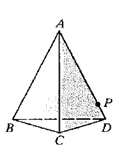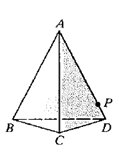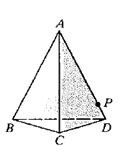
Concept explainers
(a)
To check: The postulate that guarantees the existence of the plane ABC, ABD, ACD, BCD .
(a)
Answer to Problem 18WE
It is the postulate 7.
Explanation of Solution
Given information:
Consider the statements below and associated figure
Points A , B , C and D are four non coplanar points

Formula used:
Through any 3 non collinear points there is exactly one plane
Calculation:
From Postulate 7, through any 3 non collinear points there is exactly one plane. From the figure, points A , B , C and D are non collinear points, therefore from above argument there will be exactly one plane through points A,B,C and A,B,D and A,C,D and B,C,D
Hence, the answer is postulate 7.
Conclusion:
It is the postulate 7.
(b)
To describe:The ruler postulate that guarantees the existence of point P between A and D .
(b)
Explanation of Solution
Given information:
Consider the statements below and associated figure
Points A, B, C and D are four non coplanar points

Formula used:
Through any 3 non collinear points there is exactly one plane
Calculation:
By Ruler Postulate, the distance between any two points equals the absolute value of the difference of coordinates. If P is between A and D , with the respective coordinates y, x , and z and assuming x < y < z
By the ruler postulate,
But y-x is positive because x < y. By similar argument, z - y and z - x are positive.
Therefore,
Therefore, the assumption of P is between A and D is correct.
Hence, the answer is P between A and D is proved by ruler postulate.
Conclusion:
The answer is P between A and D is proved by ruler postulate.
(c)
To write:The postulate that guarantees the existence of BCP.
(c)
Answer to Problem 18WE
The answer is postulate 7.
Explanation of Solution
Given information:
Consider the statements below and associated figure
Points A, B, C and D are four non coplanar points.

Formula used:
Through any 3 non collinear points there is exactly one plane
Calculation:
From Postulate 7, through any 3 non collinear points there is exactly one plane. From the figure, points B, C and P are non collinear points therefore from above argument there will be exactly one plane through points B, C, P
Hence, the answer is postulate 7.
Conclusion:
The answer is postulate 7.
(d)
To show:how there are infinite number of planes through
(d)
Answer to Problem 18WE
The infinite number of point on
Explanation of Solution
Given information:
Consider the statements below and associated figure
Points A, B, C and D are four non coplanar points

Formula used:
Through any 3 non collinear points there is exactly one plane
Calculation:
From the definition, a line segment consists of infinite number of points. This implies, there are an infinite number of points on
From Postulate 7, through any 3 non collinear points there is exactly one plane which implies each set of the three points forms a unique plane.
Hence, the answer to is infinite number of point on
Conclusion:
The infinite number of point on
Chapter 1 Solutions
McDougal Littell Jurgensen Geometry: Student Edition Geometry
Additional Math Textbook Solutions
Pre-Algebra Student Edition
Elementary Statistics (13th Edition)
Elementary Statistics: Picturing the World (7th Edition)
Elementary Statistics
Thinking Mathematically (6th Edition)
University Calculus: Early Transcendentals (4th Edition)
- Name: Date: Bell: Unit 11: Volume & Surface Area Homework 2: Area of Sectors Directions: Find the area of each shaded sector. Round to the hundredths place. 1. GH 11 in 2. KL 20 ft H F 64 G L 119 M K 3. BA 6.5 cm 4. YZ 14.2 m B 23 X 87° Y Z 5. KL = 27.1 mm J 32 L X:360-32.1 K A-3 360 7. BD 18 cm E 136 B X=32.8 127.0 (271) A: 069.13 Amm² 19=2102.13 A-136 360.16912 A:300cm² A=96.13 6. PQ = 2.8 in P R 311° 8. WZ 5.3 km V = Z 108 W D 9. HK = 25 ft G H KO 26 X 10. SR 26 m = S 73 T R Gina Wilson (All Things Algebarrow_forward538 Chapter 13 12. Given: Points E(-4, 1), F(2, 3), G(4, 9), and H(-2, 7) a. Show that EFGH is a rhombus. b. Use slopes to verify that the diagonals are perpendicular. 13. Given: Points R(-4, 5), S(-1, 9), T(7, 3) and U(4, -1) a. Show that RSTU is a rectangle. b. Use the distance formula to verify that the diagonals are congruent. 14. Given: Points N(-1, -5), O(0, 0), P(3, 2), and 2(8, 1) a. Show that NOPQ is an isosceles trapezoid. b. Show that the diagonals are congruent. Decide what special type of quadrilateral HIJK is. Then prove that your answer is correct. 15. H(0, 0) 16. H(0, 1) 17. H(7, 5) 18. H(-3, -3) I(5, 0) I(2,-3) 1(8, 3) I(-5, -6) J(7, 9) K(1, 9) J(-2, -1) K(-4, 3) J(0, -1) K(-1, 1) J(4, -5) K(6,-2) 19. Point N(3, - 4) lies on the circle x² + y² = 25. What is the slope of the (Hint: Recall Theorem 9-1.) - line that is tangent to the circle at N? 20. Point P(6, 7) lies on the circle (x + 2)² + (y − 1)² = 100. What is the slope of the line that is tangent to the circle at…arrow_forwardCan you cut the 12 glass triangles from a sheet of glass that is 4 feet by 8 feet? If so, how can it be done?arrow_forward
- Can you cut 12 glass triangles from a sheet of glass that is 4 feet by 8 feet? If so, draw a diagram of how it can be done.arrow_forwardIn triangle with sides of lengths a, b and c the angle a lays opposite to a. Prove the following inequality sin a 2√bc C α b a Warrow_forwardFind the values of x, y, and z. Round to the nearest tenth, if necessary. 8, 23arrow_forward
- 11 In the Pharlemina's Favorite quilt pattern below, vega-pxe-frame describe a motion that will take part (a) green to part (b) blue. Part (a) Part (b)arrow_forward5. 156 m/WXY = 59° 63 E 7. B E 101 C mFE = 6. 68° 8. C 17arrow_forward1/6/25, 3:55 PM Question: 14 Similar right triangles EFG and HIJ are shown. re of 120 √65 adjacent E hypotenuse adjaca H hypotenuse Item Bank | DnA Er:nollesup .es/prist Sisupe ed 12um jerit out i al F 4 G I oppe J 18009 90 ODPO ysma brs & eaus ps sd jon yem What is the value of tan J? ed on yem O broppo 4 ○ A. √65 Qx oppoEF Adj art saused taupe ed for yem 4 ○ B. √65 29 asipnisht riod 916 zelprisht rad √65 4 O ○ C. 4 √65 O D. VIS 9 OD elimiz 916 aelonsider saused supsarrow_forward
 Elementary Geometry For College Students, 7eGeometryISBN:9781337614085Author:Alexander, Daniel C.; Koeberlein, Geralyn M.Publisher:Cengage,
Elementary Geometry For College Students, 7eGeometryISBN:9781337614085Author:Alexander, Daniel C.; Koeberlein, Geralyn M.Publisher:Cengage, Elementary Geometry for College StudentsGeometryISBN:9781285195698Author:Daniel C. Alexander, Geralyn M. KoeberleinPublisher:Cengage Learning
Elementary Geometry for College StudentsGeometryISBN:9781285195698Author:Daniel C. Alexander, Geralyn M. KoeberleinPublisher:Cengage Learning

